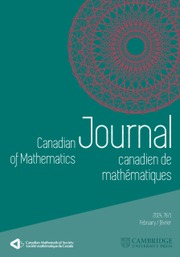Article contents
Asymptotic Formulae for the Lattice Point Enumerator
Published online by Cambridge University Press: 20 November 2018
Abstract
Let  $M$ be a convex body such that the boundary has positive curvature. Then by a well developed theory dating back to Landau and Hlawka for large
$M$ be a convex body such that the boundary has positive curvature. Then by a well developed theory dating back to Landau and Hlawka for large  $\lambda$ the number of lattice points in
$\lambda$ the number of lattice points in  $\lambda M$ is given by
$\lambda M$ is given by  $G\left( \lambda M \right)=V\left( \lambda M \right)+O\left( {{\lambda }^{d-1-\varepsilon \left( d \right)}} \right)$ for some positive
$G\left( \lambda M \right)=V\left( \lambda M \right)+O\left( {{\lambda }^{d-1-\varepsilon \left( d \right)}} \right)$ for some positive  $\varepsilon (d)$ . Here we give for general convex bodies the weaker estimate
$\varepsilon (d)$ . Here we give for general convex bodies the weaker estimate
 $$|G\left( \lambda M \right)-V\left( \lambda M \right)|\,\le \,\frac{1}{2}{{S}_{{{Z}^{d}}}}\left( M \right){{\lambda }^{d-1}}+o\left( {{\lambda }^{d-1}} \right)$$
$$|G\left( \lambda M \right)-V\left( \lambda M \right)|\,\le \,\frac{1}{2}{{S}_{{{Z}^{d}}}}\left( M \right){{\lambda }^{d-1}}+o\left( {{\lambda }^{d-1}} \right)$$
where  ${{S}_{{{Z}^{d}}}}\left( M \right)$ denotes the lattice surface area of
${{S}_{{{Z}^{d}}}}\left( M \right)$ denotes the lattice surface area of  $M$ . The term
$M$ . The term  ${{S}_{{{Z}^{d}}}}\left( M \right)$ is optimal for all convex bodies and
${{S}_{{{Z}^{d}}}}\left( M \right)$ is optimal for all convex bodies and  $o\left( {{\lambda }^{d-1}} \right)$ cannot be improved in general. We prove that the same estimate even holds if we allow small deformations of
$o\left( {{\lambda }^{d-1}} \right)$ cannot be improved in general. We prove that the same estimate even holds if we allow small deformations of  $M$ .
$M$ .
Further we deal with families  $\left\{ {{P}_{\lambda }} \right\}$ of convex bodies where the only condition is that the inradius tends to infinity. Here we have
$\left\{ {{P}_{\lambda }} \right\}$ of convex bodies where the only condition is that the inradius tends to infinity. Here we have
 $$|G\left( {{P}_{\lambda }} \right)-V\left( {{P}_{\lambda }} \right)|\,\le \,dV\left( {{P}_{\lambda }},\,K;1 \right)+o\left( S\left( {{P}_{\lambda }} \right) \right)$$
$$|G\left( {{P}_{\lambda }} \right)-V\left( {{P}_{\lambda }} \right)|\,\le \,dV\left( {{P}_{\lambda }},\,K;1 \right)+o\left( S\left( {{P}_{\lambda }} \right) \right)$$
where the convex body  $K$ satisfies some simple condition,
$K$ satisfies some simple condition,  $V\left( {{P}_{\lambda }},K;1 \right)$ is some mixed volume and
$V\left( {{P}_{\lambda }},K;1 \right)$ is some mixed volume and  $S\left( {{P}_{\lambda }} \right)$ is the surface area of
$S\left( {{P}_{\lambda }} \right)$ is the surface area of  ${{P}_{\lambda }}$ .
${{P}_{\lambda }}$ .
Information
- Type
- Research Article
- Information
- Copyright
- Copyright © Canadian Mathematical Society 1999
References
- 3
- Cited by

